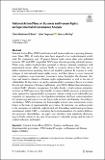Files in this item
National Action Plans on business and human rights : an experimentalist governance analysis
Item metadata
| dc.contributor.author | O'Brien, Claire Methven | |
| dc.contributor.author | Ferguson, John | |
| dc.contributor.author | McVey, Marisa | |
| dc.date.accessioned | 2021-09-08T15:30:03Z | |
| dc.date.available | 2021-09-08T15:30:03Z | |
| dc.date.issued | 2021-09-08 | |
| dc.identifier | 275671188 | |
| dc.identifier | 71955628-c178-4344-954d-f9d5c5217895 | |
| dc.identifier | 000693879900001 | |
| dc.identifier | 85114424789 | |
| dc.identifier.citation | O'Brien , C M , Ferguson , J & McVey , M 2021 , ' National Action Plans on business and human rights : an experimentalist governance analysis ' , Human Rights Review , vol. First Online . https://doi.org/10.1007/s12142-021-00637-x | en |
| dc.identifier.issn | 1524-8879 | |
| dc.identifier.other | ORCID: /0000-0002-2655-3258/work/99804244 | |
| dc.identifier.other | ORCID: /0000-0002-1604-7677/work/99804717 | |
| dc.identifier.uri | https://hdl.handle.net/10023/23925 | |
| dc.description | Research for this article was partly funded by Danida, “Realising the SDGS: The role of responsible business”. | en |
| dc.description.abstract | National Action Plans (NAPs) on business and human rights are a growing phenomenon. Since 2011, 42 such plans have been adopted or are in-development worldwide. By comparison, only 39 general human rights action plans were published between 1993 and 2021. In parallel, NAPs have attracted growing scholarly interest. While some studies highlight their potential to advance national compliance with international norms, others criticise NAPs as cosmetic devices that states use to deflect attention from persisting abuses and needed regulation. In response to wider critiques of international human rights norms, and their failure to exact universal state compliance, experimentalist governance theory highlights the dynamic, dialogic and iterative character of human rights implementation as well as the role of stakeholders. In this article, we apply experimentalist governance theory to evaluate the role and character of business and human rights NAPs. Rather than attempting to evaluate NAPs’ ultimate consequences for rights-holders, which appears premature, we focus on NAPs processes. Specifically, we analyse NAPs processes in twenty-five states against five experimentalist governance criteria relating to (i) stakeholder participation; (ii) agreement on a broad problem definition; (iii) local contextualisation; (iv) monitoring and peer review and (v) periodic revision and learning. According to our findings, NAPs on business and human rights in most states demonstrate resemblance to the traits of experimentalist governance. In particular, our analysis points to the emergence of relatively sophisticated and demanding institutional governance mechanisms within NAPs — including the institutionalisation of complex deliberative processes. Nevertheless, our paper also identifies some significant shortcomings in NAPs, related to the lack of inclusion of vulnerable groups and the lack of explicit indicators and targets. | |
| dc.format.extent | 29 | |
| dc.format.extent | 1217884 | |
| dc.language.iso | eng | |
| dc.relation.ispartof | Human Rights Review | en |
| dc.subject | National Action Plans (NAPs) | en |
| dc.subject | Buisness and human rights | en |
| dc.subject | Experimentalist governance | en |
| dc.subject | UN Guiding Principles on Business and Human Rights (UNGPs) | en |
| dc.subject | HD28 Management. Industrial Management | en |
| dc.subject | 3rd-DAS | en |
| dc.subject.lcc | HD28 | en |
| dc.title | National Action Plans on business and human rights : an experimentalist governance analysis | en |
| dc.type | Journal article | en |
| dc.contributor.institution | University of St Andrews. Centre for the Study of Philanthropy & Public Good | en |
| dc.contributor.institution | University of St Andrews. School of Management | en |
| dc.contributor.institution | University of St Andrews. Centre for Social and Environmental Accounting Research | en |
| dc.identifier.doi | 10.1007/s12142-021-00637-x | |
| dc.description.status | Peer reviewed | en |
This item appears in the following Collection(s)
Items in the St Andrews Research Repository are protected by copyright, with all rights reserved, unless otherwise indicated.

